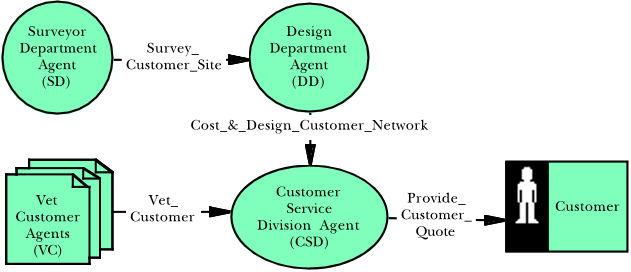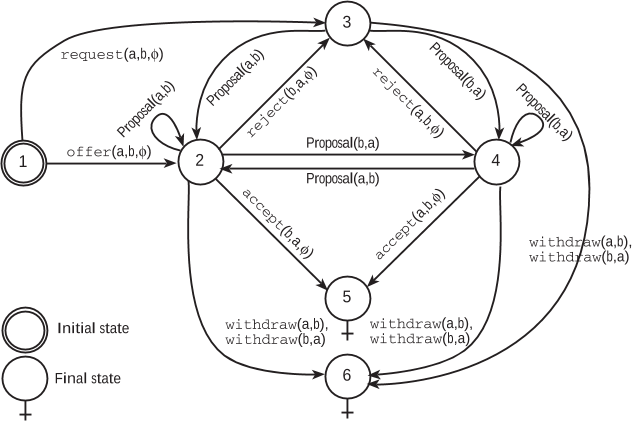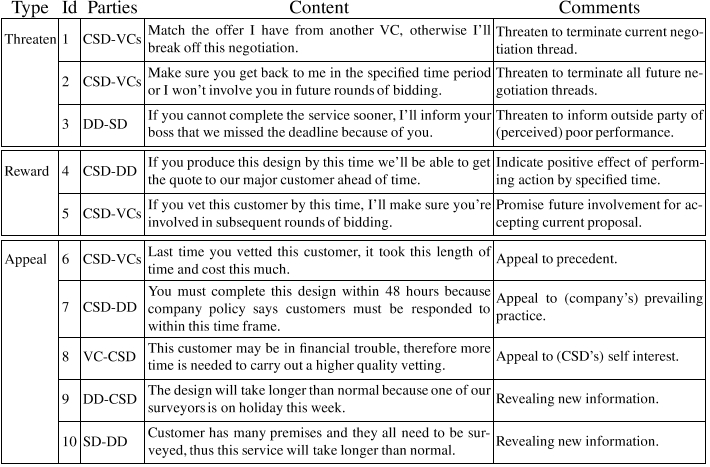
A framework for argumentation-based negotiation
Carles Sierra
z
?
, Nick R. Jennings
z
,PabloNoriega
y
??
, Simon Parsons
z
z
Department of Electronic Engineering,
Queen Mary and Westfield College,
University of London, London E1 4NS, UK.
f
C.A.Sierra, N.R.Jennings, S.D.Parsons
g
@qmw.ac.uk
y
Artificial Intelligence Research Institute, IIIA.
Spanish Scientific Research Council, CSIC.
Campus UAB, 08193 Bellaterra, Barcelona, Spain.
f
sierra, pablo
g
@iiia.csic.es
Abstract. Many autonomous agents operate in domains in which the co-
operation of their fellow agents cannot be guaranteed. In such domains negoti-
ation is essential to persuade others of the value of co-operation. This paper de-
scribes a general framework for negotiation in which agents exchange proposals
backed by arguments which summarise the reasons why the proposals should be
accepted. The argumentation is persuasive because the exchanges are able to alter
the mental state of the agents involved. The framework is inspired by our work
in the domain of business process management and is explained using examples
from that domain.
Keywords: Automated negotiation, Argumentation, Persuasion.
1 Introduction
Negotiation is a key form of interaction in systems composed of multiple autonomous
agents. In such environments, agents often have no inherent control over one another
and so the only way they can influence one another’s behaviour is by persuasion. In
some cases, the persuadee may require little or no convincing to act in the way desired
by the persuader , for example because the proposed course of action is consistent wit h
their plans. However, in other cases, the persuadee may be unwilling to accept the pro-
posal initially and must be persuaded to change its beliefs, goals or preferences so that
the proposal, or some variant thereof, i s accepted. In either case, the minimum require-
ment for negotiation is for the agents to be able to make proposals to one another. These
proposals can t hen either be accepted or rejected as is the case in the contract net pro-
tocol [17], for instance. Another level of sophistication occurs when recipients do not
just have the choice of accepting or rejecting proposals, but have the option of making
?
On sabbatical leave from IIIA
y
thanks to a Spanish MEC grant PR95-313. Research partially
supported by the Spanish CICYT project SMASH, TIC96-1038-C04001.
??
On leave from Laboratorio Nacional de Inform´atica Avanzada—LANIA. R´ebsamen, 80;
Xalapa, Veracruz, Mexico. Enjoying a Mexican CONACYT grant [69068-7245].

counter offers t o alter aspects of the proposal which are unsatisfactory [16]. An even
more elaborate form of negotiation—argumentation-based—is that in which parties are
able to send justifications or arguments along with (counter) proposals indicating why
they should be accepted [11, 13, 18]. Arguments such as: “this is my final offer, take
it or leave i t ”, “last ti me this job cost $5, I’m not going to pay $10 now”, and “the job
will t ake l onger than usual because one of the workers is off sick” may be necessary to
change the persuadee’s goals or preferences.
This paper deals with argumentation-based negotiation. Because this is a large re-
search topi c [9, 19] we limit our scope to argumentation between computational agents
where a persuader t ries to convince a persuadee to undertake a particular probl em solv-
ing t ask (service) on its behalf. We outline t he components of a formal model for the
process of argumentation-based negotiation which can ultimately be used to build ne-
gotiating agents for real world applications. While we draw on our previous work i n this
area, in thi s paper we shift our attention from the mechanisms for generating counter
proposals [16] and t hose for generating and interpreting arguments [13] to the social
aspects of the negotiation. Moreover, we take advantage of the work on Dialogical
Frameworks introduced in [12] to define the static aspects of the negotiation process:
shared ontology, social relations, communication l anguage and protocol. We define a
minimal not i on of the state of an agent which captures the evolutionary character of
negotiation—enabling t he resulting model to recognise different types of arguments
that agents can make in support of t heir proposals. Finally, we indi cate how t hese argu-
ments can be generated and interpreted by agents.
In the paper we discuss three types of illocutions: (i) threats—failure to accept this
proposal means something negative will happen to the agent; (ii) rewards—acceptance
of this proposal means something positive will happen to the agent; and (iii) appeals—
the agent should prefer t his option over t hat alternative for this reason. We realise these
are a subset of the illocutions that are involved in persuasive negotiation (see [9] for a
list based on psychological research), but our emphasis is in providing an overarching
framework in which the key components of argumentation can be described, rather t han
providing an exhaustive formalisation of all the argument types which can be found in
the literature. We illustratethese constructs through a running example introduced in the
following section. The main contribution of this work i s, therefore, to provide a formal
framework in which agents can undertake persuasive negotiation to change each other’s
beliefs and preferences using an expressive communication language. Moreover, the
framework is neutral with respect to the agent’s internal architecture and imposes few
constraints on it s formal resources.
2 Argumentation in Business Process Management
This section describes the scenario which will be used to illustrate the principles and
concepts of our model of argumentation. The scenario is motivated by work in the
ADEPT project [8] which has developed negotiating agents for business process man-
agement applications. In particular, we consider a multi-agent system for managing a
British Telecom (BT) business process—namely, providing a quotation for designing
a network which offers particular services to a customer (Figure 1). The overall pro-

cess receives a customer service request as its input and generates as its output a quote
specifying how much it would cost to build a network to realise that service. Here
we consider a subset of t he agents involved in this activity: the customer service divi-
sion (CSD) agent, t he design division (DD) agent, t he surveyor department (SD) agent,
and the various agents who provide the out-sourced service of vetting customers (VC
agents). A full account of all the agents and their negotiations is given in [16].
Provide_
Customer_
Quote
Cost_&_Design_Customer_Network
Survey_
Customer_Site
Vet_
Customer
Customer
Service
Division Agent
(CSD)
Design
Department
Agent
(DD)
Surveyor
Departmen
t
Agent
(SD)
Customer
Vet
Customer
Agents
(VC)
Fig. 1. Agent system for BT’s “
P r ovide C ustomer Quote
” business process. The direction of
the arrow indicates who provides the service labelling the arrow to whom.
The first stages of t he Provide Customer Quote service involve the CSD agent cap-
turing basic i nformation about the customer and vetting the customer in terms of their
credit worthiness. The latter service i s performed by one of the VC agents and ne-
gotiation is used to determine which one is selected. If the customer fails the vetting
procedure, then the quot e process terminates. Assuming the customer is satisfactory,
the C SD agent maps their requirements against a service portfolio. If the requirements
can be met by a standard off-the-shelf portfolio i t em then an immediate quote can be
offered based on previous examples. In the case of bespoke services t he process is more
complex. The CSD agent negotiates with the DD agent for the service of costing and de-
signing the desired network service. To prepare a network design it is usually necessary
to have a detailed plan of t he existing equipment at the customer’s premises. Sometimes
such plans might not exist and sometimes they may be out of date. In either case, the
DD agent determines whether t he customer site(s) should be surveyed. If such a survey
is warranted, the DD agent negotiates with the SD agent for the Survey
Customer Site
service. This negotiation differs from the others present in this scenario in that the two
agents are part of the same department. Moreover, the DD agent has a degree of author-
ity over SD. Agent negotiation is still required to set the timings of the service, but the
SD agent cannot simply refuse to perform the service. On completion of the network
design and costing, the DD agent informs the CSD agent which i nforms t he customer
of the service quote. The business process t hen terminates.
The precise nature of the argumentation which can occur in the aforementioned ne-
gotiations is determined by three main factors: (i) the negotiation arity—pairwise (1
to 1) negotiations (e.g. the CSD and DD agents for t he design network service) dif-
fer from 1 to many negotiations (e.g. the CSD and VC agents for the Vet
Customer

Type Id Parties Content Comments
Threaten 1 CSD-VCs
Match the offer I have from another VC, otherwise I’ll
break off this negotiation.
Threaten to terminate current nego-
tiation thread.
2 CSD-VCs
Make sure you get back to me in the specified time period
or I won’t involve you in future rounds of bidding.
Threaten to terminate all future ne-
gotiation threads.
3 DD-SD
If you cannot complete the service sooner, I’ll inform your
boss th at we missed the d eadline because of you.
Threaten to inform outside party of
(perceived) poor performance.
Reward 4 CSD-DD
If you produce this design by this time we’ll be able to get
the quote to our major customer ahead of time.
Indicate positive effect of perform-
ing action by specified time.
5 CSD-VCs
If you vet this customer by this time, I’ll make sure you’re
involved in subsequent rounds of bidding.
Promise future involvement for ac-
cepting current proposal.
Appeal 6 CSD-VCs
Last time you vetted this customer, it took this length of
time and cost this much.
Appeal to precedent.
7 CSD-DD
You must complete this design within 48 hours because
company policy says customers must be responded to
within this time frame.
Appeal to (company’s) prevailing
practice.
8 VC-CSD
This customer may b e in financial trouble, therefore more
time is needed to carry out a higher quality vetting.
Appeal to (CSD’s) self interest.
9 DD-CSD
The design will take longer than normal because one of o ur
surveyors is on holiday this week.
Revealing new information.
10 SD-DD
Customer has m any premises and they all need to be sur-
veyed, thus this service will take longer than normal.
Revealing new information.
Fig. 2. Sample arguments in the BT application.
service); (ii) the power relations [2] between the negotiators—most negotiations are
peer-to-peer, but t he DD and SD negotiation over the Survey
Customer Site service is
an example of boss-to-subordinate negotiation; and (iii) the organisational relationship
of the negotiators—some negotiations are between agents of the same organisation (e.g.
the CSD, DD and SD agents), while others are between agents of different organisations
(e.g. the CSD and VC agents). Our experience in the domain shows that the argumen-
tation between agents can be captured by the three types of argument mentioned in
the Int roduction—t hreats, rewards and appeals. Some examples of such arguments are
given in Figure 2.
3 Negotiation model
Our model describes the process of a single encounter negotiation between multiple
agents over a deal. Deals are always between two agents, though an agent may be en-
gaged simultaneously in negotiation with many agents for a given deal. Negotiation
is achieved through the exchange of illocutions in a shared communication l anguage
CL
. The actual exchange of illocutions is driven by the participating agents’ individual
needs and goals—something that will not be part of this negotiation model. Neverthe-
less, this exchange is subject to some minimal shared conventions on the int ended usage
of the illocutions in
CL
, and a simple negotiation protocol. These conventions relate to:
1. The elements that are relevant for t he negotiation of a deal—in the form of issues
and values that may evolve as negotiation proceeds.

2. The rationality of the participating agents—in terms of some form of preference
relationships or utility functions which enable the agents to evaluate and compare
different proposals.
3. The deliberation capability of the participating agents—in the form of an internal
state in which the agent may register the history of the negotiation as well as the
evolution of i t s own theoretical elements on which it s decisions are founded.
4. The minimal shared meaning of the acceptable illocutions—this is captured in the
way that a r eceived illocution should be interpreted when heard by an agent, and
by making explicit the conditions t hat enable an agent to use (or ‘generate’) a given
illocution at a given time.
A minimal set of concepts which are necessary to represent the static components in
automated negotiation are presented i n Section 3.1, and the dynamic components—the
concepts of a negotiation thread and a negotiation state—are introduced in Section 3.2.
Social aspects that are relev ant for persuasive arguments are dealt with in Section 3.3,
and the process of interpreting and generating illocutions is illustrated in Section 3.4.
3.1 A Basic Negotiation Ontology
Negotiation requires communication between the agents and, for it to be unambiguous,
each agent must ha v e a unique identifier. We denote t he set of identifiers of the agents in-
volved in a negotiation as
Agents
3
. The agents involved in a negotiation will have a va-
riety of social relationships with one another. These relationships have an important im-
pact upon t he persuasion and argumentation process. For instance, prestigious speakers
have a large persuasive impact and peers can be persuaded more easily than non-peers
[9]. To model this characteristic, we assume that a general and shared social relation
is defined between the agents. This relation can be modelled as a binary function over
a set of social roles, denoted as
Roles
. In the BT scenario, for example,
Roles
would
be:
f
C ustomer C ontr actor B oss P eer
g
. Finally, we assume that agents, when ne-
gotiating, interchange illocutions in a common communication language
CL
defined
over a set of illocutionary particles whose propositional content is expressed in a shared
logical l anguage
L
4
. The precise nature of
L
is unimportant in our model (e.g. it could
be a propositional language or a modal l anguage), however it must contain at least the
following:
1. Variables. To represent t he issues under negotiation. They have to be variables be-
cause issues need to be bound to different values during negotiation.
2. Constants. To represent values for the issues under negotiation. A special constant
‘?’ is needed to represent the absence of value, and allow for underdefined proposals
between agents. (Note this constant does not mean “don’t care”.)
3
In practice, this set may change dynamically (e.g. new vetting companies may be created and
old ones may disappear). However, since this process can be seen as independent from the
negotiation process, our model is presented with respect to a fixed set.
4
In practice, agents often have heterogeneous information models and so need to use one of the
variety of techniques for allowing them to interoperate [5, 7]. However, in this work we adopt
the simplest solution and assume a common language.



